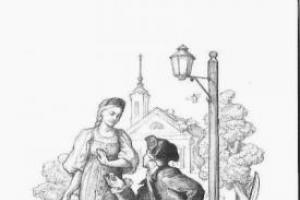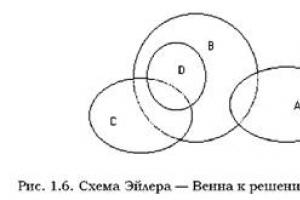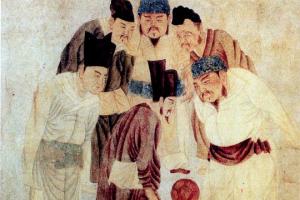The Principality of Lithuania was initially Lithuanian-Russian in composition with a predominance of Russians and could become a powerful Orthodox state. It is unknown what would have happened to the Principality of Moscow if the Lithuanian princes had not turned to the West, towards Poland.
Zhemgola, Zhmud, Prussians and others
Lithuanian tribes, close to the Slavs, judging by both language studies and analysis of beliefs, lived quite calmly and carelessly on the Baltic coast between the Western Dvina and the Vistula. They were divided into tribes: on the right bank of the Dvina lived the Letgola tribe, on the left - the Zhemgola, on the peninsula between the mouth of the Neman and the Gulf of Riga - the Korsi, between the mouths of the Neman and the Vistula - the Prussians, in the Neman basin - the Zhmud in the upper reaches, and Lithuania itself - on average, plus the most dense of the listed Yotvingians on Narva. Cities in these territories did not exist until the 13th century, when the city of Voruta among the Lithuanians and Tveremet among Zhmudi were first noted in the chronicle, and historians tend to attribute the formation of the beginnings of the state to the 14th century.
German knights
Young and aggressive Europeans, mainly Germans, as well as Swedes and Danes, naturally could not help but begin colonizing the eastern Baltic Sea. So the Swedes took the lands of the Finns, the Danes built Revel in Estland, and the Germans went to the Lithuanians. At first they only traded and preached. The Lithuanians did not refuse to be baptized, but then they plunged into the Dvina and “washed away” the baptism from themselves, sending it back to the Germans by water. The pope then sent the crusaders there, led by Bishop Albert, the first bishop of Livonia, who in 1200 founded Riga, the Order of the Swordsmen, fortunately there were plenty of knights in those days, and conquered and colonized the surrounding lands. Thirty years later, another order, the Teutonic Order, was located nearby, in the possessions of the Polish prince Konrad of Mazovia, which was driven out of Palestine by the Muslims. They were called upon to defend Poland from the Prussians, who constantly robbed the Poles. The knights conquered all Prussian lands in fifty years and a state was founded there in fief subordination from the Emperor of Germany.
The first reliable reign
But the Lithuanians did not submit to the Germans. They began to unite in large groups and build alliances, in particular, with the Polotsk princes. Considering that the Russian western lands were weak at that time, the passionate Lithuanians, who were called into service by one or the other prince, acquired primitive management skills, and began to seize first the Polotsk land, then the lands of Novgorod, Smolensk, and Kyiv. The first reliable reign was that of Mindaugas, the son of Romgold, who created a principality of Russians and Lithuanians. However, it was impossible to turn around too much, since in the South there was a strong Galician principality led by Daniel, and on the other side the Livonian Order was not asleep. Mindovg ceded the occupied Russian lands to Daniil's son Roman, but formally retained power over them and consolidated this matter by marrying his daughter to Daniil's son Shvarna. The Livonian Order recognized Mindaugas when he was baptized. As a sign of gratitude, he handed over to the Germans letters of approval for Lithuanian lands, which he did not own.
Founder of the dynasty
After the death of Mindaugas, as one would expect, various civil strife began in the principality, which lasted half a century, until in 1316 the princely throne was occupied by Gedimin, the founder of the Gedimin dynasty. Over the previous years, Daniil and other Russian princes had great influence in Lithuania and transferred a lot there in terms of urban planning, cultural and military. Gediminas was married to a Russian and, in general, pursued a Lithuanian-Russian policy, understanding that this was necessary for the construction of the state. But he subjugated Polotsk, Kyiv, and partly Volyn. He himself sat in Vilna, and two-thirds of his state were Russian lands. The sons of Gediminas Olgerd and Keistut turned out to be friendly guys - one sat in Vilna, and was engaged in north-eastern Russia, and Keistut lived in Troki, and acted against the Germans.
Jagiello - apostate
Befitting the sound of his name, Prince Jagiello turned out to be the unworthy son of Olgerd; he agreed with the Germans to destroy his uncle Keistut. That Jagiello won, but did not kill his nephew, and in vain, because at the first opportunity Jagiello strangled his uncle, but his son Vytautas was able to hide with the Teutonic knights, however, he later returned and settled on small lands. The Poles began to approach Jagiello with a proposal to marry him to Queen Jadwiga. She was recognized as queen after the death of the Hungarian King Louis, who ruled according to the dynastic principle in Poland. The lords argued and fought for a long time about who Jadwiga should take as a husband, and Jagiello was very suitable: the disputes over Volyn and Galich would stop, Poland would strengthen itself against the Germans who captured the Polish seaside, and would drive the Hungarians out of Galich and Lvov. Jagiello, baptized into Orthodoxy, was very happy at the offer, was baptized into Catholicism and baptized Lithuania. In 1386, the marriage was concluded and Jagiello received the name Vladislav. He destroyed pagan temples, etc., helped remove the Hungarians and inflicted a crushing defeat on the Teutonic Order at Grunwald. But, as Russian historian Sergei Platonov notes, the union “introduced the seeds of internal hostility and decay into Lithuania,” since the preconditions were created for the oppression of Orthodox Russians.
Vytautas - collector of lands
The son of the murdered Keistut, Vytautas, as soon as Jagiello left for Poland, with the help of appanage princes, began to rule in Poland (1392), and with such support that he achieved complete personal independence from King Vladislav, the former Jagiello. Under Vytautas, Lithuania expanded from the Baltic to the Black Sea and advanced deeply to the East at the expense of the Smolensk Principality. Vasily I was married to Vytautas's only daughter Sophia, and the left tributary of the Oka Utra was designated as the border between Moscow and Lithuanian lands. Some historians believe that this powerful eastern policy, which could lead to the creation of a huge Lithuanian-Russian state, was promoted by the Orthodox princes of Lithuania, but was sharply opposed by the Poles and the new Polized Lithuanian nobility, which received all the privileges of the gentry and lords. Vytautas even began to apply for a royal title to the Emperor of Germany in order to become independent from Poland, but died (1430) in the midst of this process.
Full union
For more than 100 years, the union was largely formal. This, as in the case of Vytautas, could have the most dire consequences for Poland, so it was decided to always elect one person as both prince and king. Thus, the union conceived in 1386 was implemented only at the beginning of the 16th century. Polish influence in Lithuania began to grow after this. Previously, local princes could rule in their lands without Catholic and Polish dictates, now the Grand Duke subjugated them, the Roman faith became suppressive and oppressive towards the Orthodox. Many converted to Catholicism, others tried to fight, moved to Moscow, which, thanks to this situation, was able to squeeze Lithuania. In the internal politics of the principality, the Polish order was finally established, first of all, the gentry with its enormous rights in relation to the king and peasants. This process naturally ended in 1569 with the Union of Lublin and the formation of another state - the Polish-Lithuanian Commonwealth.
In the XIV-XV centuries. The Grand Duchy of Lithuania and Russia was a real rival of Muscovite Rus' in the struggle for dominance in Eastern Europe. It strengthened under Prince Gediminas (ruled 1316-1341). Russian cultural influence prevailed here at this time. Gedemin and his sons were married to Russian princesses, and the Russian language dominated at court and in official business. Lithuanian writing did not exist at that time. Until the end of the 14th century. Russian regions within the state did not experience national-religious oppression. Under Olgerd (reigned 1345-1377), the principality actually became the dominant power in the region. The position of the state was especially strengthened after Olgerd defeated the Tatars in the Battle of Blue Waters in 1362. During his reign, the state included most of what is now Lithuania, Belarus, Ukraine and the Smolensk region. For all residents of Western Rus', Lithuania became a natural center of resistance to traditional opponents - the Horde and the Crusaders. In addition, in the Grand Duchy of Lithuania in the middle of the 14th century, the Orthodox population numerically predominated, with whom the pagan Lithuanians lived quite peacefully, and sometimes unrest was quickly suppressed (for example, in Smolensk). The lands of the principality under Olgerd extended from the Baltic to the Black Sea steppes, the eastern border ran approximately along the current border of the Smolensk and Moscow regions. There were trends leading towards the formation of a new version of Russian statehood in the southern and western lands of the former Kyiv state.
FORMATION OF THE GRAND DUCHIES OF LITHUANIA AND RUSSIAN
In the first half of the 14th century. A strong state appeared in Europe - the Grand Duchy of Lithuania and Russia. It owes its origin to Grand Duke Gediminas (1316-1341), who during the years of his reign captured and annexed the Brest, Vitebsk, Volyn, Galician, Lutsk, Minsk, Pinsk, Polotsk, Slutsk and Turov lands to Lithuania. The Smolensk, Pskov, Galicia-Volyn and Kiev principalities became dependent on Lithuania. Many Russian lands, seeking protection from the Mongol-Tatars, joined Lithuania. The internal order in the annexed lands did not change, but their princes had to recognize themselves as vassals of Gediminas, pay him tribute and supply troops when necessary. Gediminas himself began to call himself “the king of the Lithuanians and many Russians.” The Old Russian (close to modern Belarusian) language became the official language and language of office work of the principality. In the Grand Duchy of Lithuania there was no persecution on religious or national grounds.
In 1323, Lithuania had a new capital - Vilnius. According to legend, one day Gediminas was hunting at the foot of the mountain at the confluence of the Vilni and Neris rivers. Having killed a huge aurochs, he and his warriors decided to spend the night near an ancient pagan sanctuary. In a dream, he dreamed of a wolf dressed in iron armor, who howled like a hundred wolves. The high priest Lizdeika, called to interpret the dream, explained that he should build a city in this place - the capital of the state and that the fame of this city would spread throughout the world. Gediminas listened to the priest's advice. A city was built, which took its name from the Vilna River. Gediminas moved his residence here from Trakai.
From Vilnius in 1323-1324, Gediminas wrote letters to the Pope and the cities of the Hanseatic League. In them, he declared his desire to convert to Catholicism and invited artisans, merchants, and farmers to Lithuania. The Crusaders understood that Lithuania’s adoption of Catholicism would mean the end of their “missionary” mission in the eyes of Western Europe. Therefore, they began to incite local pagans and Orthodox Christians against Gediminas. The prince was forced to abandon his plans - he announced to the papal legates about the alleged mistake of the clerk. However, Christian churches in Vilnius continued to be built.
The Crusaders soon resumed military operations against Lithuania. In 1336 they besieged the Samogitian castle of Pilenai. When its defenders realized that they could not resist for long, they burned the castle and themselves died in the fire. On November 15, 1337, Ludwig IV of Bavaria presented the Teutonic Order with a Bavarian castle built near the Nemunas, which was to become the capital of the conquered state. However, this state had yet to be conquered.
After the death of Gediminas, the principality passed to his seven sons. The Grand Duke was considered the one who ruled in Vilnius. The capital went to Jaunutis. His brother Kestutis, who inherited Grodno, the Principality of Trakai and Samogitia, was unhappy that Jaunutis turned out to be a weak ruler and could not come to his aid in the fight against the crusaders. In the winter of 1344-1345, Kestutis occupied Vilnius and shared power with his other brother, Algirdas (Olgerd). Kestutis led the fight against the crusaders. He repelled 70 campaigns to Lithuania by the Teutonic Order and 30 by the Livonian Order. There was not a single major battle in which he did not take part. Kestutis’s military talent was appreciated even by his enemies: each of the crusaders, as their own sources report, would consider it the greatest honor to shake Kestutis’s hand.
Algirdas, the son of a Russian mother, like his father Gediminas, paid more attention to the seizure of Russian lands. During the years of his reign, the territory of the Grand Duchy of Lithuania doubled. Algirdas annexed Kyiv, Novgorod-Seversky, Right Bank Ukraine and Podol to Lithuania. The capture of Kyiv led to a clash with the Mongol-Tatars. In 1363, the army of Algirdas defeated them at Blue Waters, the southern Russian lands were freed from Tatar dependence. Algirdas' father-in-law, Prince Mikhail Alexandrovich of Tver, asked his son-in-law for support in the fight against Moscow. Three times (1368, 1370 and 1372) Algirdas made a campaign against Moscow, but could not take the city, after which peace was eventually concluded with the Moscow prince.
After the death of Algirdas in 1377, civil strife began in the country. The throne of the Grand Duke of Lithuania was given to the son of Algirdas from his second marriage, Jagiello (Yagello). Andrei (Andryus), the son from his first marriage, rebelled and fled to Moscow, asking for support there. He was received in Moscow and sent to reconquer the Novgorod-Seversky lands from the Grand Duchy of Lithuania. In the fight against Andrei, Jagiello turned to the Order for help, promising to convert to Catholicism. In secret from Kestutis, a peace treaty was concluded between the Order and Jogaila (1380). Having secured a reliable rear for himself, Jagiello went with an army to help Mamai against, hoping to punish Moscow for supporting Andrei and to share with Oleg Ryazansky (also an ally of Mamai) the lands of the Moscow principality. However, Jagiello arrived at the Kulikovo field late: the Mongol-Tatars had already suffered a crushing defeat. Meanwhile, Kestutis learned of a secret agreement concluded against him. In 1381 he occupied Vilnius, expelled Jogaila from there and sent him to Vitebsk. However, a few months later, in the absence of Kestutis, Jogaila, together with his brother Skirgaila, captured Vilnius and then Trakai. Kestutis and his son Vytautas were invited to negotiations at Jogaila's headquarters, where they were captured and placed in Krevo Castle. Kestutis was treacherously killed, and Vytautas managed to escape. Jagiello began to rule alone.
In 1383, the Order, with the help of Vytautas and the Samogitian barons, resumed military operations against the Grand Duchy of Lithuania. The allies captured Trakai and burned Vilnius. Under these conditions, Jagiello was forced to seek support from Poland. In 1385, a dynastic union was concluded between the Grand Duchy of Lithuania and the Polish state in Krevo (Krakow) Castle. The following year, Jagiello was baptized, receiving the name Vladislav, married the Polish queen Jadwiga and became the Polish king - the founder of the Jagiellonian dynasty, which ruled Poland and Lithuania for over 200 years. Implementing the union in practice, Jagiello created the Vilnius bishopric, baptized Lithuania, and equalized the rights of the Lithuanian feudal lords who converted to Catholicism with the Polish ones. Vilnius received the right of self-government (Magdeburg Law).
Vytautas, who fought with Jogaila for some time, returned to Lithuania in 1390, and in 1392 an agreement was concluded between the two rulers: Vytautas took possession of the Principality of Trakai and became the de facto ruler of Lithuania (1392-1430). After campaigns in 1397-1398 to the Black Sea, he brought Tatars and Karaites to Lithuania and settled them in Trakai. Vytautas strengthened the Lithuanian state and expanded its territory. He deprived the appanage princes of power, sending his governors to manage the lands. In 1395, Smolensk was annexed to the Grand Duchy of Lithuania, and attempts were made to conquer Novgorod and Pskov. The power of Vytautas extended from the Baltic to the Black Sea. In order to provide himself with a reliable rear in the fight against the crusaders, Vytautas signed an agreement with the Grand Duke of Moscow Vasily I (who was married to Vytautas’s daughter, Sophia). The Ugra River became the borders between the great principalities.
OLGERD, AKA ALGIDRAS
V. B. Antonovich (“Essay on the History of the Grand Duchy of Lithuania”) gives us the following masterful description of Olgerd: “Olgerd, according to the testimony of his contemporaries, was distinguished primarily by deep political talents, he knew how to take advantage of circumstances, correctly outlined the goals of his political aspirations, and advantageously positioned alliances and successfully chose the time to implement his political plans. Extremely reserved and prudent, Olgerd was distinguished by his ability to keep his political and military plans in impenetrable secrecy. Russian chronicles, which are generally not favorable to Olgerd due to his clashes with northeastern Russia, call him “evil,” “godless,” and “flattering”; however, they recognize in him the ability to take advantage of circumstances, restraint, cunning - in a word, all the qualities necessary to strengthen one’s power in the state and to expand its borders. In relation to various nationalities, it can be said that all Olgerd’s sympathies and attention were focused on the Russian people; Olgerd, according to his views, habits and family connections, belonged to the Russian people and served as its representative in Lithuania.” At the very time when Olgerd strengthened Lithuania by annexing the Russian regions, Keistut was its defender before the crusaders and deserved the glory of the people's hero. Keistut is a pagan, but even his enemies, the crusaders, recognize in him the qualities of an exemplary Christian knight. The Poles recognized the same qualities in him.
Both princes divided the administration of Lithuania so precisely that Russian chronicles know only Olgerd, and German ones only know Keistut.
LITHUANIA AT THE RUSSIA MILLENNIUM MONUMENT
The lower tier of figures is a high relief on which, as a result of a long struggle, 109 finally approved figures are placed, depicting outstanding figures of the Russian state. Under each of them, on a granite base, there is a signature (name), written in a Slavic stylized font.
The figures depicted on the high relief are divided by the author of the Monument project into four sections: Enlighteners, Statesmen; Military people and heroes; Writers and artists...
The Department of State People is located on the eastern side of the Monument and begins directly behind the “Enlighteners” with the figure of Yaroslav the Wise, after which come: Vladimir Monomakh, Gediminas, Olgerd, Vytautas, the princes of the Grand Duchy of Lithuania.
Zakharenko A.G. History of the construction of the Monument to the Millennium of Russia in Novgorod. Scientific notes" of the Faculty of History and Philology of the Novgorod State Pedagogical Institute. Vol. 2. Novgorod. 1957
A strong Lithuanian-Russian state existed on the territory of Eastern Europe for more than three centuries. The Grand Duchy of Lithuania and Russia3 arose on the lands of the former Kyiv state, where the Mongols did not “come”. The unification of Western Russian lands began in the second third of the 13th century under the Grand Duke of Lithuania Mindaugas. During the reign of Gediminas and his son Olgerd, the territorial expansion of Lithuania continued. It included Polotsk, Vitebsk, Minsk, Drutsk principalities, Turov-Pinsk Polesie, Beresteyshchyna, Volyn, Podolia, Chernigov land and part of the Smolensk region. In 1362, Prince Olgerd defeated the Tatars at the Battle of Blue Water and captured Podolia and Kiev. Indigenous Lithuania was surrounded by a belt of Russian lands, which made up 9/10 of the entire territory of the resulting state, stretching from the Baltic to the Black Sea. Today these are the Baltic states, Belarus, Ukraine.
Russian cultural influence prevailed in the new state, subjugating the politically dominant nationality - the Lithuanians. Gediminas and his sons were married to Russian princesses, and the Russian language dominated at court and in official business. Lithuanian writing did not exist at all at that time.
Until the end of the 14th century, Russian regions within the state did not experience national-religious oppression. The structure and character of local life was preserved, Rurik’s descendants remained in their economic positions, losing little in political terms, since the structure of the Lithuanian and Russian states was federal in nature. The Grand Duchy was more of a conglomeration of lands and possessions than a single political entity. For some time now, Russian cultural influence in the Lithuanian and Russian states has been increasing. The Gediminites became Russified, many of them converted to Orthodoxy. There were trends leading towards the formation of a new version of Russian statehood in the southern and western lands of the former Kyiv state.
These trends were broken when Jagiello became the Grand Duke. In 1386, he converted to Catholicism and formalized the union of the Lithuanian-Russian principality with Poland. The aspirations of the Polish gentry to penetrate the vast Western Russian lands were satisfied. Her rights and privileges quickly exceeded those of the Russian aristocracy. Catholic expansion into the western lands of Rus' began. Large regional principalities in Polotsk, Vitebsk, Kyiv and other places were abolished, self-government was replaced by governorship. The Lithuanian aristocracy changed its cultural orientation from Russian to Polish. Polonization and Catholicization captured part of the Western Russian nobility. However, the majority of Russians remained faithful to Orthodoxy and ancient traditions.
National-religious enmity began, which did not exist until the 80s of the 14th century. This enmity developed into a fierce political struggle, during which part of the Western Russian population inevitably grew stronger in favor of the Moscow state. The “departure” of Orthodox princes to Muscovy began. In 1569, under the Union of Lublin, two states - Polish and Lithuanian-Russian - united into one - the Polish-Lithuanian Commonwealth. Later, at the end of the 18th century, the Polish-Lithuanian Commonwealth ceased to exist, and its territory was divided between three states: Russia, Prussia and Austria-Hungary.
The Grand Duchy of Lithuania and Russia, Zhamoit - a strong state in the 13th - 16th centuries, was located in the territories of modern Lithuania, Belarus, partly Ukraine and Russia.
The borders of the Grand Duchy of Lithuania stretched from the Baltic to the Black Sea and from the Brest region to the Smolensk region.
The process of formation of the principality, begun by Mindovg, was completed in the 50s of the 13th century. The Principality of Lithuania included the united Lithuanian lands and part of the lands of Southern and Western Rus'.
The capital of the Principality of Lithuania is the city of Vilnia (Vilno), formerly the cities of Kernova and Novogrudok.
The official language of the principality is Old Belarusian. All codes of laws were in Belarusian.
The culture of the Grand Duchy developed under the influence of Western traditions, but at the same time relying on the ancient Russian heritage. It was strongly influenced by historical events, entailing changes in the political, socio-economic and religious situation.
According to the political system, the principality was officially a feudal monarchy.
But the state structure of the Grand Duchy of Lithuania was unique. Unlike Moscow, the creation of a centralized administration apparatus was hampered by the significant influence of the aristocracy and the autonomy of different lands.
Since the 15th century, the power of the prince in government was limited by the Rada of the Grand Duchy. The final state structure was determined in the 16th century with the formation of the Polish-Lithuanian Commonwealth with the establishment of government bodies - the Senate and the Sejm.
Chronology of the main events of the Grand Duchy of Lithuania in the 13th - 16th centuries
In 1236 - Lithuanians defeat the invading troops of the Order of the Sword under Saul.
1252 - Mindovg - became the first Lithuanian prince, united the Lithuanian lands.
In 1255 - all the lands of Black Rus' go to Daniil of Galicia; The unification of Lithuanian lands is disintegrating.
1260 - victory of the Principality of Lithuania over the Teutons at Durbe.
1293 - the reign of Vitenya begins. He carried out several campaigns in the lands of the Livonian Order. In 1307, Viten liberated Polotsk from the German knights and annexed its territory to the Principality of Lithuania.
1316 - beginning of the reign of Gediminas, founder of the Gedimin dynasty.
1345 - Olgerd Gediminovich became the head of the Principality of Lithuania.
Olgerd defeated the Teutonic Order twice (at Struve - 1348, under Udav - 1370)
1362 - victory of Olgerd at Blue Waters.
1368, 1370, 1372 - unsuccessful campaigns against Moscow in support of the Tver Principality.
1377 - the beginning of the reign of Grand Duke Jagiello Olgerdovich.
Jagiello acted as an ally of the Horde in , but did not have time to join the army of the khan.
1385 - conclusion of the Krevo Union (alliance) with Poland. Catholic expansion into the lands of Rus' begins.
1392 - Vytautas Keistutovich comes to power, disagreeing with Jagiello’s policies.
1406 - 1408 - Vitovt attacks the Principality of Moscow three times;
1404 - he captures Smolensk;
1406 - war against Pskov.
1394 - attack of the Teutonic Order on Samogitia.
In 1480, Casimir 4 promised to assist the Golden Horde in the campaign against Moscow, but did not fulfill this promise due to the invasion of the Crimean Khan.
1487 - 1494 and 1500 - 1503 - Russian-Lithuanian wars.
1512 - 1522 - war with Russia, as a result Smolensk was annexed to it.
1558 - 1583 - Livonian War.
1569 - formation of the Polish-Lithuanian Commonwealth (Lublin Union).
In ancient times, Lithuanian tribes occupied the northern lands almost to present-day Tambov. But then they merged with the Finno-Ugric and Slavic populations. Lithuanian tribes survived only in the Baltic states and Belarus. The central part of this area was occupied by the Lithuanian tribe or Lithuanians, to the west lived the Zhmud, and even further to the west lived the Prussians. In the east of modern Belarusian lands lived the Yatvags, and the Golyad tribe was located in the Kolomna region.
From these scattered tribes, the Lithuanian prince Mindovg created a single principality. After his murder by conspirators in 1263, the Lithuanian princes fought among themselves for power until the beginning of the 14th century. The winner in these internecine wars was Prince Gediminas (reigned 1316-1341). It was to him that the Grand Duchy of Lithuania owed its successful policy of conquest in the 14th century.
The very first conquest was Black Rus'. This is an area near the city of Grodno - the westernmost part of Rus'. Then Gedimin subjugated Minsk, Polotsk, and Vitebsk. After this, the Lithuanians penetrated into Galicia and Volyn. But Gedimina failed to conquer Galicia. The Poles occupied it, and the Lithuanians settled only in eastern Volyn and began to prepare for a campaign against Kyiv.

Black Rus' on the map
At the time described, Kyiv had already lost its greatness, but Stanislav, who reigned in the city, decided to defend himself and the townspeople to the end. In 1321, he entered into battle with the army of Gediminas, but was defeated. And the victorious Lithuanians besieged Kyiv. The people of Kiev were forced to submit to the Grand Duke of Lithuania on the basis of vassalage. That is, all property was left to the people of Kiev, but the Kiev prince fell into complete submission to the victors.
After the capture of Kyiv, the Lithuanian army continued its military expansion. As a result of this, Russian cities as far as Kursk and Chernigov were conquered. Thus, under Gediminas and his son Olgerd, the Grand Duchy of Lithuania arose in the 14th century. It continued its policy of conquest after the death of Gediminas, when his sons Olgerd and Keistut entered the political arena.
The brothers divided their spheres of influence. Keistut settled in Zhmudi and resisted the Germans, and Olgerd pursued a policy of conquest in the Russian lands. It should be noted that Olgerd and his nephew Vytautas formally converted to Orthodoxy. Lithuanian princes married Russian princesses and united the Rurikovichs from the Turovo-Pinsk land around them. That is, they gradually included Russian lands into the Grand Duchy of Lithuania.
Olgerd managed to subjugate a vast territory up to the Black Sea and the Don. In 1363, the Lithuanians defeated the Tatars at the Blue Waters (Sinyukha River) and captured the western part of the steppe between the Dnieper and the mouth of the Danube. Thus, they reached the Black Sea. But Lithuania continued to remain sandwiched between Orthodox Russia and Catholic Europe. The Lithuanians waged active wars with the Teutonic and Livonian Orders, and therefore Poland could become their ally.
Poland at that time was in a state of deep crisis. She was periodically tormented by both the anti-papist German orders and the Czechs, who captured Krakow and the surrounding lands. The latter were driven out with difficulty by the Polish king Wladyslaw Loketek from the Piast dynasty. In 1370, this dynasty ceased to exist, and the Frenchman Louis of Anjou became the Polish king. He passed the crown on to his daughter Jadwiga. The Polish magnates strongly advised that to marry legally with the Lithuanian prince Jogaila, the son of Olgerd. Thus, the Poles wanted to unite Poland with Lithuania and stop German expansion.
In 1385, Jagiello married Jadwiga and became the full ruler of Lithuania and Poland in accordance with the Union of Krevo. In 1387, the population of Lithuania officially adopted the Catholic faith. However, not everyone greeted this with enthusiasm. Those Lithuanians who associated themselves with the Russians did not want to accept Catholicism.
Jagiello's cousin Vitovt took advantage of this. He led the opposition and led the fight for the grand ducal throne. This man was looking for allies among the Lithuanians, and among the Poles, and among the Russians, and among the crusaders. The opposition was so strong that in 1392 Jagiello concluded the Ostrov Agreement with Vytautas. According to him, Vytautas became the Grand Duke of Lithuania, and Jogaila appropriated to himself the title of Supreme Prince of Lithuania.

Grand Duchy of Lithuania in the 14th century on the map
Vytautas continued his conquest of Russian lands and in 1395 captured Smolensk. He soon refused to obey Jogaila and, thanks to an alliance with the Tatars, annexed the large territory of the Wild Field to Lithuania. Thus, the Grand Duchy of Lithuania significantly expanded its borders in the 14th century. However, in 1399, military luck turned away from Vytautas. He lost Smolensk and part of other lands. In 1401, Lithuania was so weakened that it again entered into an alliance with Poland - the Vilna-Radom Union.
After this, Vitovt again acquired serious political weight. In 1406, an official border was established between Muscovite Russia and Lithuania. The Principality of Lithuania waged a successful fight against the Teutonic Order. In 1410, the Battle of Grunwald took place, in which the crusading knights suffered a crushing defeat. In the last years of his reign, Vytautas sought to once again separate Lithuania from Poland and, for this purpose, decided to be crowned. But this idea ended in failure.
Thus, the Grand Duchy of Lithuania in the 14th century became a militarily and politically strong state. It united, significantly expanded its borders and acquired high international authority. The adoption of Catholicism was also an important historical event. This step brought Lithuania closer to Europe, but alienated it from Rus'. This played a major political role in subsequent centuries.
Alexey Starikov








